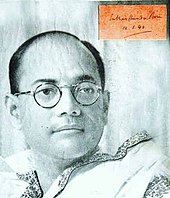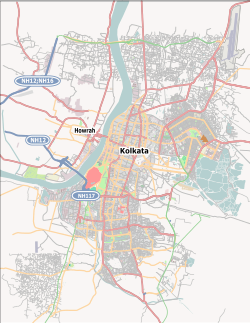Bhowanipore
This article needs additional citations for verification. (December 2006) |
Bhowanipore | |
|---|---|
Neighbourhood in Kolkata (Calcutta) | |
| Coordinates: 22°32′02″N 88°20′46″E / 22.534°N 88.346°E | |
| Country | |
| State | West Bengal |
| City | Kolkata |
| District | Kolkata |
| Metro Station | Rabindra Sadan, Netaji Bhavan and Jatin Das Park |
| Municipal Corporation | Kolkata Municipal Corporation |
| KMC wards | 70, 71, 72, 73 |
| Elevation | 36 ft (11 m) |
| Population | |
| • Total | For population see linked KMC ward pages |
| Time zone | UTC+5:30 (IST) |
| PIN | 700 020 |
| Area code | +91 33 |
| Lok Sabha constituency | Kolkata Dakshin |
| Vidhan Sabha constituency | Bhabanipur |
Bhowanipore (also Bhowanipur; Bengali: ভবানীপুর) is a neighbourhood of South Kolkata in Kolkata district in the Indian state of West Bengal.
History
[edit]In 1717, the East India Company obtained the right to rent from 38 villages surrounding their settlement from the Mughal emperor Farrukhsiyar. Of these, 5 lay across the Hooghly in what is now Howrah district. The remaining 33 villages were on the Calcutta side. After the fall of Siraj-ud-daulah, the last independent Nawab of Bengal, it purchased these villages in 1758 from Mir Jafar, and reorganised them. These villages were known en-bloc as Dihi Panchannagram and Bhowanipore was one of them. It was considered to be a suburb beyond the limits of the Maratha Ditch.[1][2][3]
Bhowanipore existed as a dihi in 1765 and also absorbed a part of Dihi Chakraberia. The construction of Harish Mukherjee Road and Lansdowne Road (now Sarat Bose Road) and the extension of Hazra Road to Kalighat, opened up the area at the beginning of the 20th century.[4] Artisans played a role in developing the neighbourhood and making it a populous native place. The kansaris (braziers), the shankharis (conch workers) and the telis (oil pressers); all had their paras. The goods were sold in pattis. Along with these artisans, Indian lawyers flocked to Bhowanipore, as the Sadr Diwani Adalat, the highest appellate court in those days, had shifted to the old Military Hospital Building here, and the District Judge's court was in Alipore.[4][5]
In 1888, one of the 25 newly organized police section houses was located in Bhowanipore.[4]
When the Bengal Renaissance started taking roots in 19th century Calcutta, it was initially limited to the predominantly Hindu 'Indian town' stretching north and north-east from the fringes of Burrabazar, with a somewhat later extension to south and south-east of the 'European town' to Bhowanipore, and some decades later to Ballygunge, which was then developing as a suburb.[6]
In the first half of the 20th century, “in the milieu of relative urban prosperity... Calcutta’s rich citizens – those connected with jute, coal, tea, other industries, trade, money-lending and rentier income from urban property – did fabulously well for themselves.” Many of the mansions in Ballygunge, Bhowanipore and Alipore were built by the city's Bengali and the new Marwari elite who wanted to move from the “dirtier sections of north Calcutta to the more fashionable areas in the south”.[7]
Again, it was in the first half of the 20th century that with the implementation of the Area Improvement Programme of Calcutta Improvement Trust Bhowanipore, an old residential suburb was upgraded to modern standards of town planning.[8]
Notable residents
[edit]
- Subhas Chandra Bose, one of the frontline Freedom Fighters of British India, founder of the Forward Bloc and the Indian National Army
- Hemant Kumar, famous singer, composer, director and producer, lived near Kansari Para in his youth and attended Mitra Institution school of Bhowanipore area.
- Anil Kumar Gain, a prominent mathematician from the University of Cambridge, Fellow of the Royal Society
- Satyajit Ray, world-renowned film-maker, composer and author
- Guru Dutt, renowned Indian film director, producer, actor, choreographer, and writer
- Deshbandhu Chittaranjan Das, renowned barrister and president of Swaraj Party
- Brajendranath De, early Indian member of the Indian Civil Service
- Tarun Kumar, actor
- Uttam Kumar, actor, composer and director
- Ashutosh Mukherjee, vice-chancellor of the University of Calcutta
- Shyama Prasad Mukherjee, founder of Jan Sangh and first union industry minister of India
- Premendra Mitra, Author and Poet
- Siddhartha Shankar Ray, former Chief Minister of West Bengal, Barrister
- Bijon Bhattacharya, eminent theatre artist, director and famous Bengali play writer, also the husband of eminent international award-winning social worker and writer Smt.Mahasweta Devi.
- Ranjit Mallick, Bengali film actor.
- Hana Catherine Mullens (1826–1861), European missionary, educator, translator and writer, notable for zenana missions
- Alphonse François Lacroix, missionary and translator
- Munna Mitra, first-class cricketer and Anglican clergyman
Geography
[edit]Location
[edit]It is located south of the Lower Circular Road (now A.J.C. Bose Road). It is bounded by Lansdown Road (presently Sarat Bose Road) to the east, Hazra Road to the south and Tolly Nullah to the west. It consists of well-known and posh localities like Elgin Road, Gokhale Road, Woodburn Park, Bakulbagan Road, Harish Mukherjee Road, Townshend Road and parts of Chakraberia and Lansdowne.
Police district
[edit]Bhowanipur police station is part of the South division of Kolkata Police.[9]
Tollygunge Women's police station has jurisdiction over all the police districts in the South Division, i.e. Park Street, Shakespeare Sarani, Alipore, Hastings, Maidan, Bhowanipore, Kalighat, Tollygunge, Charu Market, New Alipur and Chetla.[9]
Places of interest
[edit]- Netaji Bhawan
- Bhowanipore Cemetery
- Tarakeshwar Mandir
- Nandan, West Bengal Film Centre
- Academy of Fine Arts
- Jain Temple
- Shree Swaminarayan Mandir
- Forum Courtyard Mall
Demographics
[edit]Business opportunities brought many Gujaratis to Calcutta about a century back and they opted to stay in the Lansdowne-Chakraberia-Puddapukur belt of Bhowanipore. The railways, the jute mills and the shipping industry brought in many Punjabis to Calcutta. The Harish Mukherjee Road area of Bhowanipore and Dunlop (in north Kolkata) were the biggest pockets of Punjabi settlement. With declining economic opportunities many of both the communities are leaving Kolkata.[10][11] Writing about the Bhabanipur (Vidhan Sabha constituency), from where the West Bengal chief minister, Mamata Banerjee, contests, Hindustan Times said, "The constituency has a sizable population of Sikhs and Gujaratis. However, it is dominated by middle-class Bengalis."[12]
For language and religion census data, available at the district level, see Kolkata district.
Culture
[edit]Bhowanipore was also known as the Cinema Para, or the locality of the city which boasted of a string of cinema halls. The stretch started with Purna near Jadu Babu's Bazaar and was followed up by Bharati, Indira, Bijoli, Basusree, Kalika, and Ujjwala, right up to the recesses of the Kalighat Temple. They were primarily famous for their screenings of Bengali, English and Hindi movies. However, due to the lack of patronage and drying up of the Bengali film box office in the mid-90s, and the first decade of the 2000s, most of these halls have been closed down. Basusree, Indira and Bijoli are still operational, though the condition is not that well of, Bharati, Kalika, and Ujjwala have been demolished to make way for multi-storied buildings that host malls, educational institutes, and marriage halls. Purna has been closed down for more than a decade now, and there is little hope that it will be opened again.
The area also has the 23 Palli Durga Mandir, a small Temple which houses an Ashta Dhaatu Murti of Durga, and near the well known Kalighat Kali Temple, and the Nakuleshwar Bhairav Temple, considered one of the holiest of the holies in Hindu religion.
Healthcare
[edit]
- Chittaranjan National Cancer Institute
- SSKM Hospital
- Sambhunath Pandit Hospital
- Health Point Hospital
- Ramrikdas Haralalka Hospital
- Anandalok Hospital
- Fortis Medical Centre, Kolkata
- Bangur Institute of Neurosciences
Education
[edit]- Asutosh College, S. P. Mukherjee Road
- Mitra Institution, Bhowanipore Branch
- South Suburban School (Main)
- Sir Ramesh Mitra Girls High School
- Chakraberia High School
- Adarsh Hindi High School
- Ballygunge Government High School
- Baba Saheb Ambedkar Education University (BSAEU)
- Gokhale Memorial Girls' College
- St.Helen School
- Bhawanipore Girls High School
- Vidyanjali International School
- Khalsa High School
- Hartley High School, Sarat Bose Road
- Acharya Jagadish Chandra Bose College, Elgin Road
- Bhawanipur Education Society College, Elgin Road
- Bhawanipur Gujarati Balmandir
- J. J. Ajmera High School, Heysham Road
- Julien Day School, Elgin Road and Ramesh Mitra Road.
- St. John's Diocesan Girls' Higher Secondary School
- Cathedral Mission High School, Elgin Road
- South Calcutta Girls' College
- IPGME&R and SSKM Hospital, Acharya Jagadish Chandra Bose Road
Sports
[edit]A club named Bhawanipore FC, founded by Nani Mitra in 1910, stands at the entrance of the Maidan near the Rani Rashmani Statue and presently managed by the Sangbad Pratidin group, represents Bhawanipore in both the domestic and regional tournaments.[13] The club is two time runners-up in the I-League 2nd Division in 2014–15[14] and 2019–20.[15]
References
[edit]- ^ "District Census Handbook Kolkata, Census of India 2011, Series 20, Part XII A" (PDF). Pages 6-10: The History. Directorate of Census Operations, West Bengal. Retrieved 20 February 2018.
- ^ Cotton, H.E.A., Calcutta Old and New, first published 1909/reprint 1980, pages 103-4 and 221, General Printers and Publishers Pvt. Ltd.
- ^ Nair, P.Thankappan, The Growth and Development of Old Calcutta, in Calcutta, the Living City, Vol. I, pp. 14-15, Edited by Sukanta Chaudhuri, Oxford University Press, 1995 edition.
- ^ a b c Nair, P.Thankappan, The Growth and Development of Old Calcutta, in Calcutta, the Living City, Vol. I, pp. 15,18-19, Edited by Sukanta Chaudhuri, Oxford University Press, 1995 edition.
- ^ Cotton, H.E.A., Calcutta Old and New, first published 1909/reprint 1980, page 223, General Printers and Publishers Pvt. Ltd.
- ^ Sarkar, Sumit, "Calcutta and the 'Bengal Renaissance", in Calcutta, the Living City, Vol. I, p. 100, Edited by Sukanta Chaudhuri, Oxford University Press, 1995 edition.
- ^ Goswami, Omkar, “Calcutta’s Economy 1918-1970 The Fall from Grace”, “Calcutta, The Living City” Vol II, Edited by Sukanta Chaudhuri, Page 93, First published 1990, 2005 edition, ISBN 0-19-563697-X
- ^ Chatterjee, Monideep, "Town Planning in Calcutta: Past, Present and Future", "Calcutta, The Living City" Vol II, Edited by Sukanta Chaudhuri, Page 141, First published 1990, 2005 edition, ISBN 0-19-563697-X
- ^ a b "Kolkata Police". South Division – Bhawanipur police station. KP. Retrieved 5 March 2018.
- ^ "People in Pockets". Gujarat Capital and Flavours of Punjab. The Telegraph, 16 March 2008. Archived from the original on 13 May 2008. Retrieved 5 March 2018.
- ^ "Gujaratis tread the exit route". The Telegraph, 30 April 2003. Archived from the original on 25 June 2003. Retrieved 5 March 2018.
- ^ "Bhowanipore: Mamata Banerjee's constituency is Trinamool's citadel". Hindustan Times, 20 April 2016. 20 April 2016. Retrieved 5 March 2018.
- ^ "Bhawanipore FC Started Pre-Season Training". THIF-Live. Archived from the original on 2 April 2015. Retrieved 13 March 2015.
- ^ "ROYAL WAHINGDOH ARE SECOND DIVISION CHAMPIONS". I-League. 11 April 2014. Archived from the original on 13 April 2014. Retrieved 11 April 2014.
- ^ I-League 2nd Division 2020 Final Round League Table i-league.org. Retrieved 1 March 2021
External links
[edit]![]() Kolkata/South travel guide from Wikivoyage
Kolkata/South travel guide from Wikivoyage

